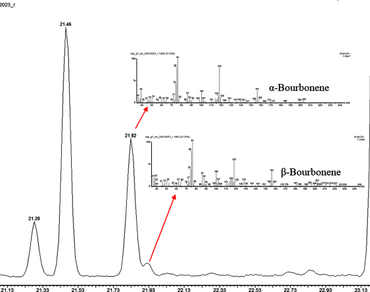Essential oil profile of Garcinia Pushpangadaniana, a recently described species from the Western Ghats of India
Research Articles | Published: 16 January, 2024
First Page: 307
Last Page: 313
Views: 2862
Keywords: Cadinene-type, α-Calacorene, (E)-Caryophyllene, α-Corocalene, n Garcinia Pushpangadanianan , Spirolepechinene
Abstract
The medicinally important genus Garcinia is widespread in the Western Ghats and the Northeast Regions of India. Three accessions of Garcinia pushpangadaniana from two populations were studied during pre-monsoon and monsoon seasons. Dried leaves were subjected to hydro-distillation to extract essential oil and chemical composition of the essential oils were determined using gas chromatography (GC) and gas chromatography-mass spectrometry (GC-MS) techniques. (E)-Caryophyllene was the major compound with 14.05%, 18.96%, and 15.60% in all three accessions respectively. Sesquiterpene compounds with cadinene-type skeleton were found to be the key compounds in G. pushpangadaniana, making up 47.65–49.67% of the EO. These include δ-cadinene (12.79–14.38%), γ-muurolene (9.56–9.87%) and γ-cadinene (5.93–6.94%). The compounds such as spirolepechinene, α-calacorene, α-corocalene, caryophylla-4(12),8(13)-dien-5-ol and cadalene are identified as unique compounds in G. pushpangadaniana essential oil, and these marker compounds can be used for the authentication of this species.

References
Aboaba S, Akande A, Flamini G (2014) Chemical composition, toxicity and antibacterial activity of the essential oils of Garcinia mangostana from Nigeria. J Essent Oil Bear Plants 17:78–86. https://doi.org/10.1080/0972060X.2014.884759
Adams RP (2007) Identification of Essential Oil Components by Gas Chromatography/Mass Spectrometry, 4th edn. Allured publishing corporation, Carol Stream
Baruah S, Barman P, Basumatary S, Bhuyan B (2021) Diversity and ethnobotany of genus Garcinia L. (Clusiaceae) in Assam, Eastern Himalaya. Ethnobot Res Appl 21:1–14. https://doi.org/10.32859/era.21.33.1-14
Chagonda LS, Chalchat J-C (2005) The essential oil of the fruit of Garcinia Huillensis Welw. Ex. Oliv from Zimbabwe Flavour Fragr J 20:313–315. https://doi.org/10.1002/ffj.1420
Darshani P, Sundaresan V, Pragadheesh VS (2023) Chemical composition and chiral analysis of β-myrcene rich essential oil from Glossocardia bosvallia L.f. DC Nat Prod Res 37:498–501. https://doi.org/10.1080/14786419.2021.1973466
Fernandez CMM, Lorenzetti FB, Iwanaga CC, Bernuci KZ, Simoes LP, de Andrade JPP, Bortolucci W, de Goncalves C, Cortez JE, Gazim DAG, Filho ZCD, B.P (2021) Chemical composition and seasonal variation of the essential oils of leaves of Garcinia Gardneriana (Planchon and Triana) Zappi (Clusiaceae). Aust J Crop Sci 15:1–8
Mahabusarakam W, Chairerk P, Taylor WC (2005) Xanthones from Garcinia cowa Roxb. latex. Phytochemistry 66, 1148–1153. https://doi.org/10.1016/j.phytochem.2005.02.025
Martins A, Salgueiro L, Vila R, Tomi F, Cañigueral S, Casanova J, da Cunha A, Adzet T (1999) Composition of the essential oils of Ocimum canum, O. Gratissimum, and O. minimum. Planta Med 65:187–189. https://doi.org/10.1055/s-2006-960465
Masullo M, Bassarello C, Suzuki H, Pizza C, Piacente S (2008) Polyisoprenylated benzophenones and an unusual polyisoprenylated tetracyclic xanthone from the fruits of Garcinia Cambogia. J Agric Food Chem 56:5205–5210. https://doi.org/10.1021/jf800416j
Menon LN, Shameer PS, Sarma J, Rameshkumar KB (2021) Profiles of volatile chemicals from the leaves of six Garcinia species from North East India. Nat Prod Res 35:2269–2273. https://doi.org/10.1080/14786419.2019.1667349
Morteza-Semnani K, Saeedi M, Akbarzadeh M (2014) Chemical composition of the essential oil of Salvia Limbata C. A. Mey J Essent Oil Bear Plants 17:623–628. https://doi.org/10.1080/0972060X.2014.935067
Nguyen CN, Trinh BTD, Tran TB, Nguyen L-TT, Jäger AK, Nguyen L-HD (2017) Anti-diabetic xanthones from the bark of Garcinia xanthochymus. Bioorg Med Chem Lett 27:3301–3304. https://doi.org/10.1016/j.bmcl.2017.06.021
Nguyen NH, Nguyen MT, Nguyen HD, Pham PD, Thach UD, Trinh BTD, Nguyen LTT, Dang SV, Do AT, Do BH (2021) Antioxidant and antimicrobial activities of the extracts from different Garcinia species. Evid. Based Complement. Alternat. Med. 2021, 1–9. https://doi.org/10.1155/2021/5542938
Parthasarathy U, Babu K, Kumar R, Ashis GR, Mohan S, Va P (2013) Diversity of Indian Garcinia - A medicinally important spice crop in India. Acta Hortic 979:467–476. https://doi.org/10.17660/ActaHortic.2013.979.50
Raju R, Manikandan G, Nambi S (2020) Phytochemical composition and antimicrobial properties of leaf essential oil of Garcinia imberti Bourd. and G. travancorica Bedd 29, 1082–1092
Rameshkumar K, Aravind A, Menon LN (2016) Leaf volatile chemical profiles of Garcinia species in the western ghats, in: Diversity of Garcinia Species in the western ghats: Phytochemical Perspective. Jawaharlal Nehru Tropical Botanic Garden and Research Institute, Palode, Thiruvananthapuram, Kerala, India, pp 101–112
Sabu T, Mohanan NN, Krishnaraj MVN, Shareef SM, Shameer PS, Roy PE (2013) Garcinia Pushpangadaniana (Clusiaceae), a new species from the southern western ghats, India. Phytotaxa 116:51. https://doi.org/10.11646/phytotaxa.116.2.2
Shameer P, Rameshkumar K, Mohanan N (2016a) Diversity of Garcinia species in the western ghats, in: Diversity of Garcinia Species in the western ghats: Phytochemical Perspective. Jawaharlal Nehru Tropical Botanic Garden and Research Institute, Palode, Thiruvananthapuram, Kerala, India, pp 01–18
Shameer P, Rameshkumar K, Sivu A (2016b) Morphological, chemical and molecular taxonomy of a new Garcinia species - Garcinia pushpangadaniana Sabu in: Diversity of Garcinia Species in the Western Ghats: Phytochemical Perspective. Jawaharlal Nehru Tropical Botanic Garden and Research Institute, Palode, Thiruvananthapuram, Kerala, India, pp 123–131
Silva RF, Rezende CM, Santana HCD, Vieira RF, Bizzo HR (2013) Scents from Brazilian Cerrado: Chemical composition of the essential oil from the leaves of Hyptis Villosa Pohl ex Benth (Lamiaceae). J Essent Oil Res 25:415–418. https://doi.org/10.1080/10412905.2013.828327
Tan W-N, Lim J-Q, Afiqah F, Nik Mohamed Kamal NNS, Abdul Aziz FA, Tong W-Y, Leong C-R, Lim J-W (2018) Chemical composition and cytotoxic activity of Garcinia Atroviridis Griff. Ex T. Anders. Essential oils in combination with tamoxifen. Nat Prod Res 32:854–858. https://doi.org/10.1080/14786419.2017.1361951
Tan W-N, Tong W-Y, Leong C-R, Kamal NM, Muhamad NNS, Lim M, Khairuddean J-W, Her M, Man MB (2020) Chemical composition of essential oil of Garcinia Gummi-Gutta and its antimicrobial and cytotoxic activities. J Essent Oil Bear Plants 23:832–842. https://doi.org/10.1080/0972060X.2020.1828179
Xu G, Kan WLT, Zhou Y, Song J-Z, Han Q-B, Qiao C-F, Cho C-H, Rudd JA, Lin G, Xu H-X (2010) Cytotoxic acylphloroglucinol derivatives from the twigs of Garcinia Cowa. J Nat Prod 73:104–108. https://doi.org/10.1021/np9004147
Author Information
Analytical Chemistry and Phytochemistry Lab, CSIR–Central Institute of Medicinal and Aromatic Plants, Research Centre, Bengaluru, India